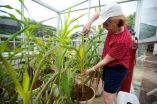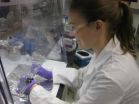(Press-News.org) According to a study published today in PLOS Pathogens, children who live in regions of the world where malaria is common can mount an immune response to infection with malaria parasites that may enable them to avoid repeated bouts of high fever and illness and partially control the growth of malaria parasites in their bloodstream. The findings may help researchers develop future interventions that prevent or mitigate the disease caused by the malaria parasite.
Each year, approximately 200 million cases of malaria occur worldwide, resulting in roughly 627,000 deaths (mostly children less than the age of 5 years living in sub-Saharan Africa). In 2013, 97 countries had ongoing malaria transmission, according to the World Health Organization. Unlike individuals who are newly exposed to malaria, people living in malaria-endemic regions often do not experience malaria-induced fever and manage to control parasite numbers in the bloodstream. To better understand why, researchers analyzed immune cells from children in Mali who are bitten by malaria-infected mosquitos more than 100 times per year, yet experience malaria fever only two times per year on average. The scientists collected blood samples from children on three occasions: before the start of the six-month malaria season; seven days after each child had been treated for his or her first malaria fever of the season, when symptoms had cleared; and after the subsequent six-month dry season, when little to no malaria transmission occurs.
To simulate malaria infection at these time points, researchers exposed the immune cells to malaria parasites in a test tube. They found that immune cells collected before the malaria season responded by producing large amounts of molecules that cause inflammation, fever and other malaria symptoms. Conversely, cells collected after the first bout of malaria fever responded by producing molecules that control inflammation and destroy the malaria parasite. The third set of immune cells (those taken after the dry season when there is an absence of malaria exposure) lost their ability to produce molecules that control inflammation, leaving children susceptible again to malaria fever. According to the authors, this immune response, which appears to depend on ongoing exposure to malaria parasites, may have evolved to protect young children from potentially life-threatening inflammation and unchecked parasite growth in the face of repeated malaria infections, before they acquire antibodies that reliably protect against the onset of malaria symptoms.
INFORMATION:
The study was conducted by researchers from the National Institute of Allergy and Infectious Diseases (NIAID), part of the National Institutes of Health, and the Mali International Center of Excellence in Research, which is partially funded by NIAID.
ARTICLE:
S Portugal et al. Exposure-dependent control of malaria-induced inflammation in children. PLOS Pathogens DOI: 10.1371/journal.ppat.1004079 (2014).
Peter D. Crompton, M.D., M.P.H., chief, Malaria Infection Biology and Immunity Unit in the Laboratory of Immunogenetics, part of NIAID's Division of Intramural Research.
CONTACT:
To schedule interviews, please contact Jennifer Routh, (301) 402-1663, jennifer.routh@nih.gov. niaidnew@niaid.nih.gov.
NIAID conducts and supports research—at NIH, throughout the United States, and worldwide—to study the causes of infectious and immune-mediated diseases, and to develop better means of preventing, diagnosing and treating these illnesses. News releases, fact sheets and other NIAID-related materials are available on the NIAID Web site at http://www.niaid.nih.gov.
About the National Institutes of Health (NIH): NIH, the nation's medical research agency, includes 27 Institutes and Centers and is a component of the U.S. Department of Health and Human Services. NIH is the primary federal agency conducting and supporting basic, clinical, and translational medical research, and is investigating the causes, treatments, and cures for both common and rare diseases. For more information about NIH and its programs, visit http://www.nih.gov/.
NIH...Turning Discovery Into Health®
Study sheds light on how the immune system protects children from malaria
2014-04-18
ELSE PRESS RELEASES FROM THIS DATE:
Better thermal-imaging lens from waste sulfur
2014-04-18
Sulfur left over from refining fossil fuels can be transformed into cheap, lightweight, plastic lenses for infrared devices, including night-vision goggles, a University of Arizona-led international team has found.
The team successfully took thermal images of a person through a piece of the new plastic. By contrast, taking a picture taken through the plastic often used for ordinary lenses does not show a person's body heat.
"We have for the first time a polymer material that can be used for quality thermal imaging – and that's a big deal," said senior co-author Jeffrey ...
JCI online ahead of print table of contents for April 17, 2014
2014-04-18
Double-stapled peptide inhibits RSV infection
Respiratory syncytial virus (RSV) is a leading cause of lower respiratory tract infections, generating life-threating illness in very young and elderly populations. Despite great effort, preventive therapies are limited. RSV enters host cells through the fusion protein RSV F, which forms a six-helix fusogenic bundle. Small interfering peptides that prevent bundle formation limit RSV infection in vitro; however, these peptides are highly susceptible to degradation. In this issue of the Journal of Clinical Investigation, Loren ...
Chickens to chili peppers
2014-04-18
Suddenly there was a word for chili peppers. Information about archaeological remains of ancient chili peppers in Mexico along with a study of the appearance of words for chili peppers in ancient dialects helped researchers to understand where jalapeños were domesticated and highlight the value of multi-proxy data analysis. Their results are from one (Kraig Kraft et al.) of nine papers presented in a special feature issue of the Proceedings of the National Academy of Sciences on plant and animal domestication edited by Dolores Piperno, staff scientist emerita at the Smithsonian ...
Novel marker discovered for stem cells derived from human umbilical cord blood
2014-04-17
New Rochelle, NY, April 17, 2014—The development of stem cell therapies to cure a variety of diseases depends on the ability to characterize stem cell populations based on cell surface markers. Researchers from the Finnish Red Cross have discovered a new marker that is highly expressed in a type of stem cells derived from human umbilical cord blood, which they describe in an article in BioResearch Open Access, a peer-reviewed journal from Mary Ann Liebert, Inc., publishers. The article is available free on the BioResearch Open Access website.
Heli Suila and colleagues, ...
Five anthropogenic factors that will radically alter northern forests in 50 years
2014-04-17
COLUMBIA, Mo. April 17 – In the most densely forested and most densely populated quadrant of the United States, forests reflect two centuries of human needs, values and practices. Disturbances associated with those needs, such as logging and clearing forests for agriculture and development, have set the stage for management issues of considerable concern today, a U.S. Forest Service study reports.
The report – Five anthropogenic factors that will radically alter forest conditions and management needs in the Northern United States – was published recently by the journal ...
CU researchers discover target for treating dengue fever
2014-04-17
AURORA, Colo. (April 17, 2014) – Two recent papers by a University of Colorado School of Medicine researcher and colleagues may help scientists develop treatments or vaccines for Dengue fever, West Nile virus, Yellow fever, Japanese encephalitis and other disease-causing flaviviruses.
Jeffrey S. Kieft, PhD, associate professor of biochemistry and molecular genetics at the School of Medicine and an early career scientist with the Howard Hughes Medical Institute, and colleagues recently published articles in the scholarly journals eLife and Science that explain how flaviviruses ...
Vitamin B3 might have been made in space, delivered to Earth by meteorites
2014-04-17
Ancient Earth might have had an extraterrestrial supply of vitamin B3 delivered by carbon-rich meteorites, according to a new analysis by NASA-funded researchers. The result supports a theory that the origin of life may have been assisted by a supply of key molecules created in space and brought to Earth by comet and meteor impacts.
"It is always difficult to put a value on the connection between meteorites and the origin of life; for example, earlier work has shown that vitamin B3 could have been produced non-biologically on ancient Earth, but it's possible that an added ...
Bright points in sun's atmosphere mark patterns deep in its interior
2014-04-17
Like a balloon bobbing along in the air while tied to a child's hand, a tracer has been found in the sun's atmosphere to help track the flow of material coursing underneath the sun's surface.
New research that uses data from NASA's Solar Dynamics Observatory, or SDO, to track bright points in the solar atmosphere and magnetic signatures on the sun's surface offers a way to probe the star's depths faster than ever before. The technique opens the door for near real-time mapping of the sun's roiling interior – movement that affects a wide range of events on the sun from ...
Lab researcher discovers the green in Greenland
2014-04-17
At one point in history, Greenland was actually green and not a country covered in ice.
An international team of researchers, including a scientist from Lawrence Livermore National Laboratory, has discovered that ancient dirt in Greenland was cryogenically frozen for millions of years under nearly two miles of ice.
More than 2.5 million years ago. Greenland looked like the green Alaskan tundra, before it was covered by the second largest body of ice on Earth.
The ancient dirt under the Greenland ice sheet helps to unravel an important mystery surrounding climate change: ...
Multitarget TB drug could treat other diseases, evade resistance
2014-04-17
CHAMPAIGN, Ill. — A drug under clinical trials to treat tuberculosis could be the basis for a class of broad-spectrum drugs that act against various bacteria, fungal infections and parasites, yet evade resistance, according to a study by University of Illinois chemists and collaborators.
Led by U. of I. chemistry professor Eric Oldfield, the team determined the different ways the drug SQ109 attacks the tuberculosis bacterium, how the drug can be tweaked to target other pathogens from yeast to malaria – and how targeting multiple pathways reduces the probability of pathogens ...







